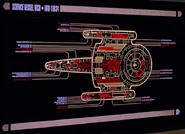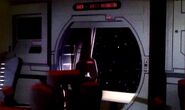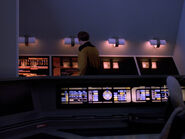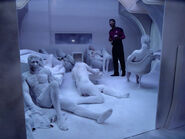m (→Studio model: typo) |
Pseudohuman (talk | contribs) (removed two notes, one was speculation, the other apocrypha) |
||
| (17 intermediate revisions by 12 users not shown) | |||
| Line 9: | Line 9: | ||
|Decks = 13 |
|Decks = 13 |
||
|Crew = 80 (standard); 5 (minimal) |
|Crew = 80 (standard); 5 (minimal) |
||
| − | |Armament = |
+ | |Armament = [[Phaser bank]] |
|Defenses = [[Deflector shield]]s |
|Defenses = [[Deflector shield]]s |
||
|image2 = USS Grissom (aft).jpg |
|image2 = USS Grissom (aft).jpg |
||
| Line 20: | Line 20: | ||
[[File:USS Pegasus.jpg|thumb|The {{USS|Pegasus}}, a failed [[prototype]]]] |
[[File:USS Pegasus.jpg|thumb|The {{USS|Pegasus}}, a failed [[prototype]]]] |
||
| − | In [[2358]], the ''Oberth''-class {{USS|Pegasus}} served as a [[prototype]] for testing advanced starship [[technology|technologies]]. The ''Pegasus'' was outfitted with an experimental engine and new weapon systems, some of which were used in the designs for {{ |
+ | In [[2358]], the ''Oberth''-class {{USS|Pegasus}} served as a [[prototype]] for testing advanced starship [[technology|technologies]]. The ''Pegasus'' was outfitted with an experimental engine and new weapon systems, some of which were used in the designs for {{Class|Galaxy}} starships. In addition to this, the ''Pegasus'' was the test bed for an illegal [[phasing cloaking device|Federation cloaking device]]. ({{TNG|The Pegasus}}) |
The Federation continued to construct ''Oberth''-class starships as late as [[2363]], at such locations as the [[USSR]]'s [[Baikonur Cosmodrome]]. ({{TNG|The Naked Now}} ''[[dedication plaque]]'') |
The Federation continued to construct ''Oberth''-class starships as late as [[2363]], at such locations as the [[USSR]]'s [[Baikonur Cosmodrome]]. ({{TNG|The Naked Now}} ''[[dedication plaque]]'') |
||
The ''Oberth'' was present in several major Federation engagements including the [[Borg]] invasion of [[2366]]-[[2367]], where it participated at the [[Battle of Wolf 359]], as well as the [[Battle of Sector 001]] in [[2373]]. ({{DS9|Emissary}}; {{film|8}}) |
The ''Oberth'' was present in several major Federation engagements including the [[Borg]] invasion of [[2366]]-[[2367]], where it participated at the [[Battle of Wolf 359]], as well as the [[Battle of Sector 001]] in [[2373]]. ({{DS9|Emissary}}; {{film|8}}) |
||
| − | |||
| − | The class would slowly be phased out of service during the [[2370s]], shortly after the introduction of the more advanced {{ShipClass|Nova}} science vessel. ({{VOY|Equinox}}) |
||
== Technical data == |
== Technical data == |
||
| Line 44: | Line 42: | ||
=== Defensive systems === |
=== Defensive systems === |
||
[[File:Oberth class firing phaser.jpg|thumb|Firing forward phaser]] |
[[File:Oberth class firing phaser.jpg|thumb|Firing forward phaser]] |
||
| − | More suited for science missions than combat missions, the ''Oberth''-class had minimal [[defensive system]]s |
+ | More suited for science missions than combat missions, the ''Oberth''-class had minimal [[defensive system]]s. They were tactically inferior to such enemy vessels as the [[Klingon Bird-of-Prey]] and the [[Borg cube]]. ({{film|3}}; {{DS9|Emissary}}; {{film|8}}) |
| + | The weapon systems of the ''Oberth''-class included a forward [[phaser bank]]. ({{film|8}}) |
||
| − | They were tactically inferior to such enemy vessels as the [[Klingon Bird-of-Prey]] and the [[Borg cube]]. ({{film|3}}; {{DS9|Emissary}}; {{film|8}}) |
||
As a science vessel, the ''Oberth''-class was designed with specialized [[shields]], which allow them to push through [[gravitational wavefront]]s. In conjunction with this feature, the interior [[bulkhead]]s were composed of [[victurium]] alloy to better facilitate shielding. ({{TNG|Hero Worship}}) |
As a science vessel, the ''Oberth''-class was designed with specialized [[shields]], which allow them to push through [[gravitational wavefront]]s. In conjunction with this feature, the interior [[bulkhead]]s were composed of [[victurium]] alloy to better facilitate shielding. ({{TNG|Hero Worship}}) |
||
=== Auxiliary craft === |
=== Auxiliary craft === |
||
| − | ''Oberth''-class starships were equipped with [[escape pod]]s, stowing a minimum |
+ | ''Oberth''-class starships were equipped with [[escape pod]]s, stowing a minimum complement of two on board a vessel with a crew of five. These escape pods were capable of transporting at least nine personnel at once. ({{TNG|Realm of Fear|The Pegasus}}) |
== Interior design == |
== Interior design == |
||
| Line 57: | Line 55: | ||
Located on Deck 1 of the saucer section, the [[bridge]] housed the ship's command center. In general, the ''Oberth''-class had a fairly standard Federation starship floor plan. |
Located on Deck 1 of the saucer section, the [[bridge]] housed the ship's command center. In general, the ''Oberth''-class had a fairly standard Federation starship floor plan. |
||
| − | Located in the front was the [[viewscreen]], with side-by-side [[navigator]] and [[helm]] consoles, which are in contrast positioned opposite to the arrangement found aboard {{ |
+ | Located in the front was the [[viewscreen]], with side-by-side [[navigator]] and [[helm]] consoles, which are in contrast positioned opposite to the arrangement found aboard {{Class|Constitution}} starships. The [[captain's chair]] is directly aft of the aforementioned stations. |
At the rear of the bridge, was a single [[turbolift]]-entryway. The primary stations, which were located at either side of the captain's chair included a primary [[science station]] to port (''pictured, below left'') with secondary stations trailing along the wall towards the back of the bridge. Along the [[starboard]] side of the bridge was the [[communications station]] (''pictured, below center''). ({{film|3}}) |
At the rear of the bridge, was a single [[turbolift]]-entryway. The primary stations, which were located at either side of the captain's chair included a primary [[science station]] to port (''pictured, below left'') with secondary stations trailing along the wall towards the back of the bridge. Along the [[starboard]] side of the bridge was the [[communications station]] (''pictured, below center''). ({{film|3}}) |
||
| Line 107: | Line 105: | ||
== Ships commissioned == |
== Ships commissioned == |
||
| + | [[File:USS Biko.jpg|thumb|The model of the [[USS Cochrane]] was used for the [[USS Biko]] in {{TNG|A Fistful of Datas}}]] |
||
;Named: |
;Named: |
||
* {{USS|Biko}} |
* {{USS|Biko}} |
||
* {{USS|Cochrane}} (NCC-59318) |
* {{USS|Cochrane}} (NCC-59318) |
||
| − | * {{USS|Copernicus}} (NCC-640) |
+ | * {{USS|Copernicus|NCC-640}} (NCC-640) |
* {{USS|Grissom|NCC-638}} (NCC-638) |
* {{USS|Grissom|NCC-638}} (NCC-638) |
||
* {{USS|Oberth}} (NCC-602) (prototype) |
* {{USS|Oberth}} (NCC-602) (prototype) |
||
| Line 122: | Line 121: | ||
;Uncertain: |
;Uncertain: |
||
| ⚫ | |||
| + | * {{USS|Helin}} (NCC-1692) |
||
* {{USS|Raman}} (NCC-29487) |
* {{USS|Raman}} (NCC-29487) |
||
* {{USS|Springfield}} (NCC-1963) |
* {{USS|Springfield}} (NCC-1963) |
||
| ⚫ | |||
== Appendices == |
== Appendices == |
||
=== Appearances === |
=== Appearances === |
||
<div class="appear"> |
<div class="appear"> |
||
| − | * |
+ | * {{Star Trek films}}: |
** {{film|3}} |
** {{film|3}} |
||
** {{film|4}} |
** {{film|4}} |
||
| Line 145: | Line 145: | ||
</div> |
</div> |
||
| − | === Background === |
+ | === Background information === |
| − | Production sources dating back to ''Star Trek III'' established an overall length for the ''Oberth''-class at 395 feet (120 meters), a length also adopted by [[Andrew Probert]] during the early production phase of [[TNG Season 1]]. |
+ | Production sources dating back to ''Star Trek III'' established an overall length for the ''Oberth''-class at 395 feet (120 meters), a length also adopted by [[Andrew Probert]] during the early production phase of [[TNG Season 1]]. {{eas|articles/excelsior/probert-sizechart.jpg}} |
According to the ''[[Star Trek Encyclopedia]]'', the ''Oberth''-class was named for {{w|Hermann Oberth}}, the "Father of German Rocketry." <!-- Note, the Encyclopedia says "German Rocketry", despite Oberth being Austrian --> |
According to the ''[[Star Trek Encyclopedia]]'', the ''Oberth''-class was named for {{w|Hermann Oberth}}, the "Father of German Rocketry." <!-- Note, the Encyclopedia says "German Rocketry", despite Oberth being Austrian --> |
||
====Studio model==== |
====Studio model==== |
||
| ⚫ | |||
| − | {{film|3}} was, tied with {{TNG|The Best of Both Worlds, Part II}}, seven each, until {{film|8}} the ''Star Trek'' production that introduced the most new space faring designs, which included the {{ShipClass|Oberth}}, at once. |
||
| − | =====Design process===== |
||
| − | [[File:Oberth Class early concept.jpg|thumb|Early design concept of the ''Oberth''-class]] |
||
| − | For ''The Search for Spock'', a unique approach to designing was adopted, not seen before or after in the ''Star Trek'' franchise. Instead of the traditional way of thinking out a design, devising a design, coming up with detailed drawings to be approved of by visual effects supervisors and building models from blueprints, this time visual artists [[David Carson (ILM)|David Carson]] and [[Nilo Rodis-Jamero]] of [[Industrial Light & Magic]] produced their pre-visualization artwork and handed it over to model makers [[Steve Gawley]], [[Bill George]] and their team to be translated into [[studio model|study model]]s, in essence inviting them to use their own imagination to finish up on the design. Very much a collaborative effort, Carson later remembered,"''We'd churn out quite a few sketches. Then the ones that were most promising we might polish up a little in color for presentation. It wasn't uncommon for me to do a drawing that would inspire Nilo, who would then turn it into his own drawing that would be much more impressive! He would often inspire me.''"({{STTM|3|8}}, p. 48) Once turned over to the model makers the resulting study models were presented to producer [[Harve Bennett]] and/or director [[Leonard Nimoy]] for appraisal or as supervising model maker Gawley put it,"''You had all these models sitting on a table so that the director could really get a feel for what we were talking about. It just made everything easier to understand, and insured that everybody was on the same page. It also made it easier to give cost estimates.''"({{STTM|3|8}}, p. 20) Director of Photography [[Kenneth Ralston]] elaborated further,"''From the beginning, once Nilo Rodis, one of the visual effects art directors, had done a sketch and they got an idea of what direction to go, the model people all built prototypes. The [[Spacedock (Earth)|space dock]] had four or five small prototypes. The [[Klingon Bird-of-Prey|Bird of Prey]], I think, had only two because we all knew this one design would work and we were selling that one. The [[Merchantman|Merchant Man]] and the ''Grissom'' also had several designs. When Leonard and Harve and [[Ralph Winter]] came to meetings we presented them with three dimensional models. It really is a lot better doing it that way because they can physically see how different angles would work.''"(''[[American Cinematographer]]'', August/September 1984, p. 62) |
||
| − | |||
| − | =====The ''Valiant'' study model ===== |
||
| − | One of the study models Ralston referred to was labeled as the ''Valiant'', and was featured in the 2002 documentary, "Space Docks and Birds of Prey", disc 2 from the [[Star Trek III: The Search for Spock (Special Edition)]] DVD, already very close to the final design. |
||
| − | {| class="wiki-sidebar" style="width:100%;" |
||
| − | |- |
||
| − | ! colspan="3" style="text-align:center;" id="The ''Valiant'' study model" | The ''Valiant'' study model |
||
| − | |- |
||
| − | | colspan="1" align="center" |[[File:Concept Model Valiant 2.jpg|205px]] |
||
| − | | colspan="1" align="center" |[[File:Valiant oberth temp.jpg|205px]] |
||
| − | | colspan="1" align="center" |[[File:Oberth class at Veridian III.jpg|205px]] |
||
| − | |- |
||
| − | | class="even" | <center>''Valiant'' overhead</center> |
||
| − | | class="even" | <center>''Valiant'' overhead</center> |
||
| − | | class="even" | <center>{{ShipClass|Oberth}} vessel assisting in the evacuation of {{USS|Enterprise|NCC-1701-D|-D}} personnel from [[Veridian III]]</center> |
||
| − | |} |
||
| − | Photo documents reportedly taken around the time of the filming of {{film|7}} of this ''Oberth''-class model has led to some speculation that it was this model that was used in the evacuation scene of [[Veridian III]]. However, screencap analysis shows that the lay-out of the impulse deflector crystals as well as the lay-out of the impulse engine exhausts/transporter emitters on the nacelle deck does not correspond with the lay-out as shown on the study model. It is also highly unlikely that a study model was outfitted with an internal lighting system. It can therefore be surmised that it was in fact the original physical studio model, still wearing the {{USS|Pegasus}} decals. |
||
| − | |||
| − | =====Physical studio models===== |
||
| ⚫ | |||
| − | The original [[studio model]] for the ''Oberth''-class, built at ILM by Gawley's team, measured an overall length of 28 inches. The model first appeared in Star Trek III as the {{USS|Grissom|NCC-638}}, and was subsequently relabeled to represent other vessels of the class (the last time for {{TNG|The Pegasus}} as the {{USS|Pegasus}}, subsequent appearances shot in such a way that the decals could not be discerned). Very little further modification, save for some paint touch-ups (possibly to repair some minor damage after Jein took molds from it) was ever performed on the model besides relabeling. The last appearance of the model was in the [[Veridian III]] evacuation scene in {{film|7}}. The model, still labeled as the USS ''Pegasus'', was auctioned off as {{stala|1778-706|Lot #706}} on 7 October 2006, being part of the [[40 Years of Star Trek: The Collection]] auction. The estimated price for the model was $4,000 – $6,000; it sold for $18,000 ($21,600 with premium). The model was added to the [http://sciencefictionarchives.com/fr/objet/219/maquette-de-luss-grissom.htm?language=EN ScienceFictionArchives.com collection] |
||
| − | |||
| − | [[File:SS Vico studio model.jpg|thumb|SS ''Vico'' studio model built at Gregory Jein Inc.]] |
||
| − | A second physical model was later created at [[Gregory Jein|Gregory Jein Inc.]] for {{TNG|Hero Worship}} to depict the severely damaged {{SS|Vico}}. At the time considered too valuable to cut up the original ILM model for showcasing the damaged ''Vico'', Jein took molds from the model and from them cast the parts to construct a new model. Co-worker [[Bruce MacRae]] helped out with detail construction and painting.[http://www.jetcafe.org/bruce/portfolio/TV_Shows2/FrameSet.htm] Jein later gave away the molds to [[John Eaves]] who actually used them to cast a solid resin model and had it gold-plated.[http://johneaves.wordpress.com/2009/06/26/more-of-the-golden-starships/#comment-5293] It, along with other starship [[model]]s, was intended for use as a display piece in the glass cabinets in the [[observation lounge]] of the {{USS|Enterprise|NCC-1701-E|-E}} in {{film|10}}. However that fell through as Eaves delivered the models too late for use.[http://johneaves.wordpress.com/2009/06/26/more-of-the-golden-starships/] The ''Vico'' model itself, having escaped the [[40 Years of Star Trek: The Collection]] and [[It's A Wrap! sale and auction]] auctions, is still in the possession of [[Paramount Pictures]] and has been on tour displays such as ''[[Star Trek World Tour]]'', ''[[Star Trek: The Adventure]]'' and ''[[Star Trek The Exhibition]]'' as late as 2011. |
||
| − | |||
| − | =====CGI model===== |
||
| − | The last appearance of the ''Oberth''-class was in {{film|8}} in the [[Battle of Sector 001]] scene. With the exception of the [[Borg cube]], [[Borg sphere]], the [[Unnamed Nebula class starships#Battle of Sector 001|unnamed ''Nebula''-class starship]] and the {{USS|Enterprise|NCC-1701-E|-E}} all other ships were done as [[CGI|CGI models]], including the at least three [[Unnamed Oberth class starships#Battle of Sector 001|''Oberth''-class starships]]. Never meant to be seen up close but rather as deep background elements, the model was built at ILM by modelers [[Larry Tan]] and [[Paul Theren]] at a fairly low resolution and at a low detail level. Noteworthy was that this was the first and only time that viewers could see an ''Oberth''-class vessel discharge it weapons. Established as an older design, the model was never used again nor was its CGI-counterpart upgraded for later appearances and the class, with the exception of the use of the physical model for {{DS9|Emissary}}, has not been seen (though referenced to) in either [[Star Trek: Deep Space Nine]] or [[Star Trek: Voyager]]. |
||
| − | ==Apocrypha== |
+ | === Apocrypha === |
| − | Non-canonically, the {{ |
+ | Non-canonically, the {{Class|Nova}} was considered by some of the production staff as the replacement for the ''Oberth''-class as research and science platform. ([[Star Trek: Starship Spotter]], p. 36) |
| − | == External links == |
+ | === External links === |
| − | * |
+ | *{{eas|articles/oberth-size.htm|Size of the ''Oberth''-class|external}}: an in-depth article assessing the size inconsistencies of the various on-screen appearances of the ''Oberth''-class starship |
| − | * |
+ | *{{NCwiki|Oberth class}} |
| − | * |
+ | *{{wikipedia|List of Starfleet starships ordered by class#Oberth class|Oberth class starship}} |
[[cs:Třída Oberth]] |
[[cs:Třída Oberth]] |
||
Revision as of 14:38, 13 January 2015
The Oberth class was a small Federation starship used primarily by Starfleet and civilian scientists alike, as a scout class and science vessel, from the late-23rd to the late-24th century.
History
In service as early as the 2280s, the Oberth-class was designed and used almost exclusively for the study of astronomical phenomena, including data gathering missions on stars and planets, well into the 2360s. (Star Trek III: The Search for Spock, Star Trek VI: The Undiscovered Country; TNG: "The Naked Now", "Hero Worship", "Realm of Fear") By the latter half of the 2360s, these vessels would serve in a number of limited capacities, such as transports and supply ships. (TNG: "The Drumhead", "The Game", "A Fistful of Datas")
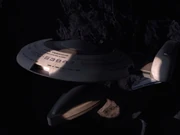
The USS Pegasus, a failed prototype
In 2358, the Oberth-class USS Pegasus served as a prototype for testing advanced starship technologies. The Pegasus was outfitted with an experimental engine and new weapon systems, some of which were used in the designs for Galaxy-class starships. In addition to this, the Pegasus was the test bed for an illegal Federation cloaking device. (TNG: "The Pegasus")
The Federation continued to construct Oberth-class starships as late as 2363, at such locations as the USSR's Baikonur Cosmodrome. (TNG: "The Naked Now" dedication plaque)
The Oberth was present in several major Federation engagements including the Borg invasion of 2366-2367, where it participated at the Battle of Wolf 359, as well as the Battle of Sector 001 in 2373. (DS9: "Emissary"; Star Trek: First Contact)
Technical data
The Oberth-class had an standard crew complement of eighty, but was capable of operating with a minimum crew complement of five. (ENT: "These Are the Voyages..."; TNG: "The Naked Now", "Realm of Fear")
Physical arrangement
Master systems display, profile |
The Oberth-class design was atypical among Federation starships of the time. The outboard plan of the Oberth's design incorporated a unique split hull design, with an upper primary hull that was composed mainly of the saucer section, which was mounted onto a rear extension that mounts the impulse drive, and warp drive nacelles to either side to the saucer. The secondary hull was connected to the primary hull at the nacelles by reinforced pylons. The secondary hull itself was oblong in shape. (Star Trek III: The Search for Spock, etc.) In all, the Oberth contained thirteen decks. (TNG: "Hero Worship")
Design features of the secondary hull included a docking port located on the port side of the hull. (DS9: "Emissary")
Defensive systems

Firing forward phaser
More suited for science missions than combat missions, the Oberth-class had minimal defensive systems. They were tactically inferior to such enemy vessels as the Klingon Bird-of-Prey and the Borg cube. (Star Trek III: The Search for Spock; DS9: "Emissary"; Star Trek: First Contact)
The weapon systems of the Oberth-class included a forward phaser bank. (Star Trek: First Contact)
As a science vessel, the Oberth-class was designed with specialized shields, which allow them to push through gravitational wavefronts. In conjunction with this feature, the interior bulkheads were composed of victurium alloy to better facilitate shielding. (TNG: "Hero Worship")
Auxiliary craft
Oberth-class starships were equipped with escape pods, stowing a minimum complement of two on board a vessel with a crew of five. These escape pods were capable of transporting at least nine personnel at once. (TNG: "Realm of Fear", "The Pegasus")
Interior design
Main bridge
Located on Deck 1 of the saucer section, the bridge housed the ship's command center. In general, the Oberth-class had a fairly standard Federation starship floor plan.
Located in the front was the viewscreen, with side-by-side navigator and helm consoles, which are in contrast positioned opposite to the arrangement found aboard Constitution-class starships. The captain's chair is directly aft of the aforementioned stations.
At the rear of the bridge, was a single turbolift-entryway. The primary stations, which were located at either side of the captain's chair included a primary science station to port (pictured, below left) with secondary stations trailing along the wall towards the back of the bridge. Along the starboard side of the bridge was the communications station (pictured, below center). (Star Trek III: The Search for Spock)
The bridge layout during the 24th century included an emergency hatch set in the bulkhead, which could be used to escape from the bridge, into space, during an emergency situation. (TNG: "The Naked Now")
Corridors
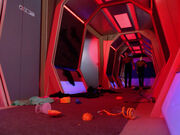
A typical corridor design
Because of its small size, many of the corridors doubled as auxiliary access points to various parts of the ship.
The anteroom, just outside the bridge, was located at the end of a corridor. This section contained a viewscreen-monitor and the ship's dedication plaque. (TNG: "The Naked Now")
Main engineering
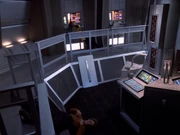
Engineering was located in the center of the ship, it was where the ship's power systems were controlled and home of the ship's antimatter warp drive chamber and impulse engine controls. (TNG: "The Pegasus")
Science and service sections
The Oberth-class was equipped with numerous science labs dedicated to scientific study.
One section, located on deck 4 in the saucer section, was a corridor-like chamber that contained a couple of science consoles and adjacent monitors against the wall. Access to the computer core could be interfaced via ODN junction located below the science consoles. The computer core itself was located on deck 13, inside the secondary hull. (TNG: "Hero Worship")
Another section, known as science ops, contained multiple computer consoles and a personnel transporter pad. (TNG: "Realm of Fear")
Accommodations
Crew quarters found aboard the Oberth-class were not unlike those found aboard other Federation starships. They included a main living area, with an attached bedroom and adjacent bathroom. (TNG: "The Naked Now")
Ships commissioned

The model of the USS Cochrane was used for the USS Biko in TNG: "A Fistful of Datas"
- Named
- USS Biko
- USS Cochrane (NCC-59318)
- USS Copernicus (NCC-640)
- USS Grissom (NCC-638)
- USS Oberth (NCC-602) (prototype)
- USS Pegasus (NCC-53847)
- SS Tsiolkovsky (NCC-53911)
- SS Vico (NAR-18834)
- USS Yosemite (NCC-19002)
- Unnamed
- Uncertain
- USS Copernicus (NCC-58637)
- USS Helin (NCC-1692)
- USS Raman (NCC-29487)
- USS Springfield (NCC-1963)
Appendices
Appearances
Background information
Production sources dating back to Star Trek III established an overall length for the Oberth-class at 395 feet (120 meters), a length also adopted by Andrew Probert during the early production phase of TNG Season 1. [1]
According to the Star Trek Encyclopedia, the Oberth-class was named for Hermann Oberth, the "Father of German Rocketry."
Studio model
Apocrypha
Non-canonically, the Nova-class was considered by some of the production staff as the replacement for the Oberth-class as research and science platform. (Star Trek: Starship Spotter, p. 36)
External links
- Size of the Oberth-class at Ex Astris Scientia: an in-depth article assessing the size inconsistencies of the various on-screen appearances of the Oberth-class starship
- Template:NCwiki
- Oberth class starship at Wikipedia


